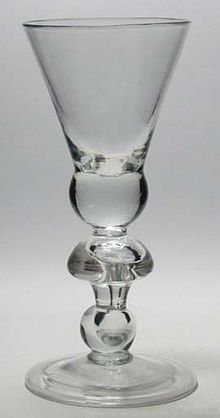
Heavy baluster glasses or goblets (French 'balustre' = 'pomegranate flower') were popular in the period 1680–1740. The baluster stem is formed in one piece with the bowl of the glass, and is then drawn out to form a tapering stem. With the manufacture of longer stems the design was embellished with knops or knobs, which were decorative shapes formed in the stem. After about 1720 the heavy baluster glasses were replaced with thinner glass and stems, featuring smaller knops, and known as light balusters or balustroids.
Baluster glasses were so named because the first stems resembled balusters, starting just from below the bowl and swelling towards the foot. Because the difficulty in grasping such a shape, it was replaced by inverted baluster with a swelling at the top. Taxes in the eighteenth century were imposed according to the weight of the glass, leading to a reduction in the size of the knops and more elegant glasses, known as light balusters or just balusters. When the knops became no more than swellings of the stem, the term balustroid was used.
See also
References
- "Heavy Baluster and Baluster Stem Georgian Wine Glasses". scottishantiques.com. Retrieved 15 Jan 2023.
- "What is a Heavy baluster glass". museumoflondon. Archived from the original on 2013-11-04.
- Bickerton, L. M. (1987). Eighteenth century English drinking glasses : an illustrated guide. D. Robert Elleray (2nd rev. ed.). Woodbridge, Suffolk: Antique Collectors' Club. ISBN 0-907462-61-8. OCLC 18053155.
- "18th Century Glass, the World's Leading Site for 18th Century Glass". Archived from the original on 2013-11-03.
- Francis, G. R. (1926). Old English drinking glasses. OCLC 614276766.